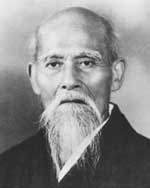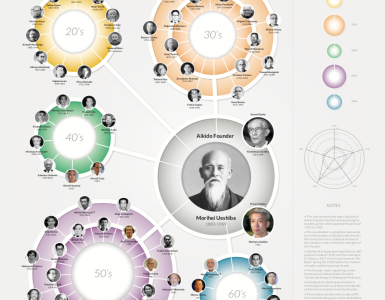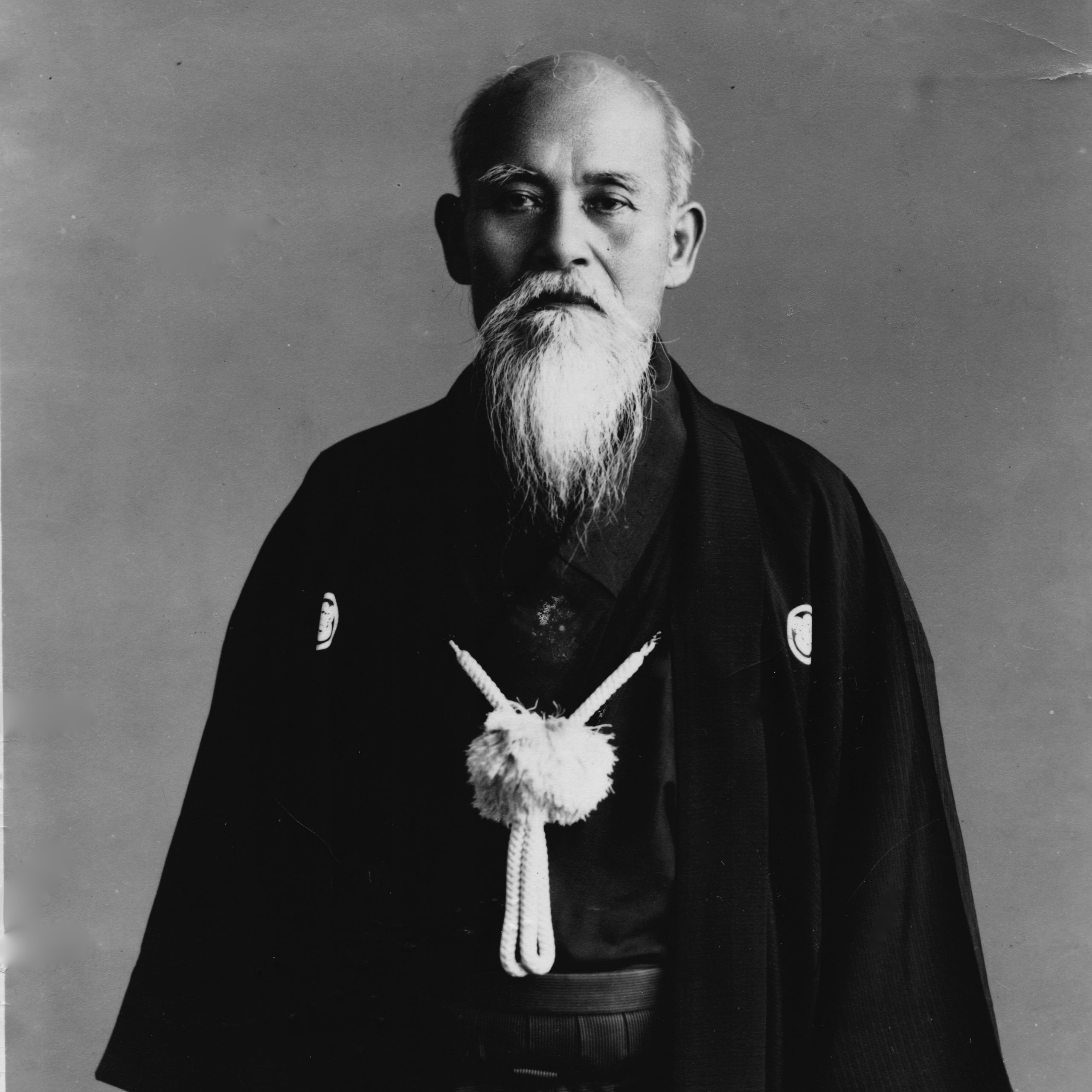 (14 December 1883-26 April 1969). Also, Tsunemori and Moritaka. Son of Yoroku and Yuki UESHIBA. Founder of aikido. B. TANABE in Kii Province (present-day Wakayama Prefecture). Ueshiba is known to have studied the following martial arts: TENJIN SHIN’YO-RYU JUJUTSU under Tokusaburo TOZAWA for a brief period in 1901 in Tokyo; GOTO-HA YAGYU SHINGAN-RYU under Masakatsu NAKAI from c. 1903 to c. 1908 in Sakai City near Osaka; judo under Kiyoichi TAKAGI c. 1911 in Tanabe; DAITO-RYU JUJUTSU under Sokaku TAKEDA beginning in 1915 in Hokkaido.
(14 December 1883-26 April 1969). Also, Tsunemori and Moritaka. Son of Yoroku and Yuki UESHIBA. Founder of aikido. B. TANABE in Kii Province (present-day Wakayama Prefecture). Ueshiba is known to have studied the following martial arts: TENJIN SHIN’YO-RYU JUJUTSU under Tokusaburo TOZAWA for a brief period in 1901 in Tokyo; GOTO-HA YAGYU SHINGAN-RYU under Masakatsu NAKAI from c. 1903 to c. 1908 in Sakai City near Osaka; judo under Kiyoichi TAKAGI c. 1911 in Tanabe; DAITO-RYU JUJUTSU under Sokaku TAKEDA beginning in 1915 in Hokkaido.
The following occurrences of the name of Morihei Ueshiba in the EIMEIROKU and SHAREIROKU of Sokaku Takeda have thus far been documented: 5 March 1915; 19 March 1915; 4 April 1915; 6 February 1916; 16 February 1916; 26 February 1916, and 8 March 1916, all in Hokkaido. Entries for AYABE are: 28 April to 11 May 1922; 1 to 10 June 1922; 11 to 19 June 1922; 1 to 10 July 1922; and 15 to 24 August 1922. An overall entry for the above 1922 period of instruction dated 28 April to 15 September 1922 is also recorded. Finally, for Tokyo, 29 March to 7 April 1931. (Single dates appearing above refer to the last day of the ten-day seminar in which Ueshiba participated). It seems likely that Ueshiba took part in additional seminars taught by Takeda. Although precise details are not known, Ueshiba also accompanied his teacher as an assistant while living in Hokkaido. Moreover, he received a Shinkage-ryu sword transmission scroll from Takeda during the latter’s 1922 stay in Ayabe.
Ueshiba was one of the most distinguished pupils of Sokaku and received the following Daito-ryu scrolls: HIDEN MOKUROKU, HIDEN OGI, and GOSHIN’YO NO TE. His direct association with this school has so far been documented from 1915 through 1937. Ueshiba also regularly observed instruction of KASHIMA SHINTO-RYU from three senior teachers of this school who taught for two or three years beginning in 1937 on his invitation at the KOBUKAN DOJO in Tokyo. He may also have been influenced by the Yagyu Shinkage-ryu sword as Kosaburo GEJO was one of his students for a number of years in 1920s and 1930s in the KOBUKAN DOJO. Despite some sources which imply otherwise, it is quite clear that the main technical influence on aikido are the Daito-ryu techniques of Sokaku TAKEDA. Ueshiba received his KYOJU DAIRI certificate in this art on 15 September 1922.
The founder of aikido was also influenced philosophically and religiously by the OMOTO RELIGION, especially the thinking of Reverend Onisaburo DEGUCHI. His involvement with this religion began in December 1919. Ueshiba lived in Ayabe from 1920 through 1927 and was active as an Omoto believer and close supporter of Deguchi. He accompanied the Omoto leader in 1924 on an ill-fated trip to Manchuria and Mongolia in an attempt to establish a utopian colony. At the urging of several high-ranking military officers, notably Admiral Isamu TAKESHITA, Ueshiba relocated to Tokyo in 1927 and taught in several locations before establishing the Kobukan Dojo in 1931.
This dojo was the center of his activities over the next 11 years where he was extremely active as a teacher of Daito-ryu Aikijujutsu. He gradually separated himself from Sokaku Takeda and began calling his art AIKI BUDO. In the late 1930s, the founder also made several trips to Manchuria where he conducted seminars and gave demonstrations. Shortly after the outbreak of the Second World War, he resigned from his teaching posts in Tokyo, which included several military schools, and retired to IWAMA.
During and immediately after the war, Ueshiba remained in Iwama and devoted himself to intensive training, meditation and farming. He repeatedly stated that it was in Iwama that he perfected modern aikido. In the mid-1950s, the founder began to spend considerable time in Tokyo and also traveled to a certain extent, often to the Kansai region. Ueshiba received the Medal of Honor with the Purple Ribbon from the Japanese government in 1960. In 1961, accompanied by Koichi TOHEI and Nobuyoshi TAMURA, he visited Hawaii to participate in the opening of the Honolulu Aikikai. His last years were spent primarily in Tokyo where his health gradually became frail. Nonetheless, he continued instructing through the early part of February 1969, until he fell ill and was admitted to Keio University Hospital. He was released to be returned home where he died of liver cancer on 26 April 1969. He was posthumously given the Buddhist name of Aiki-in Seibu Enyu Daidoshi.
Ueshiba taught tens of thousands of students during his teaching career which spanned some 50 years and is noted for his ethical and humanistic view of the martial arts which holds the concept of nonconflict, rather than the defeat of an adversary, as the ideal.











Add comment